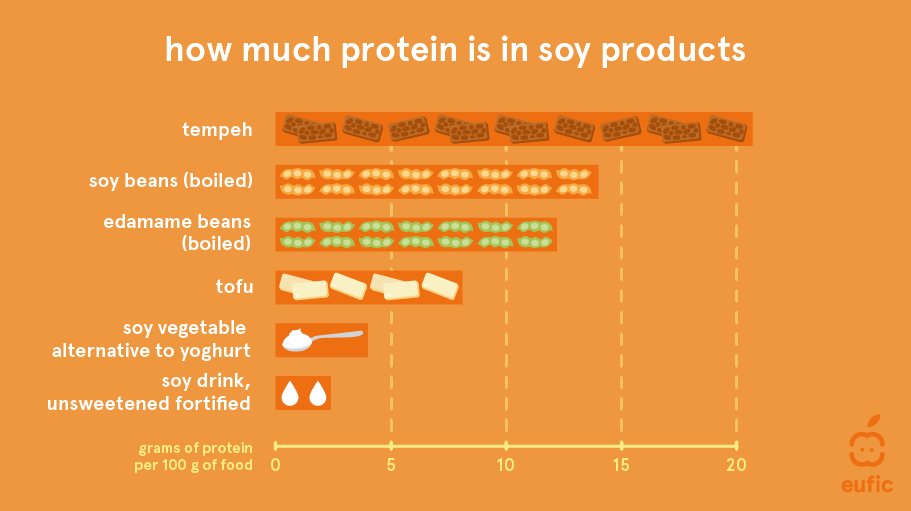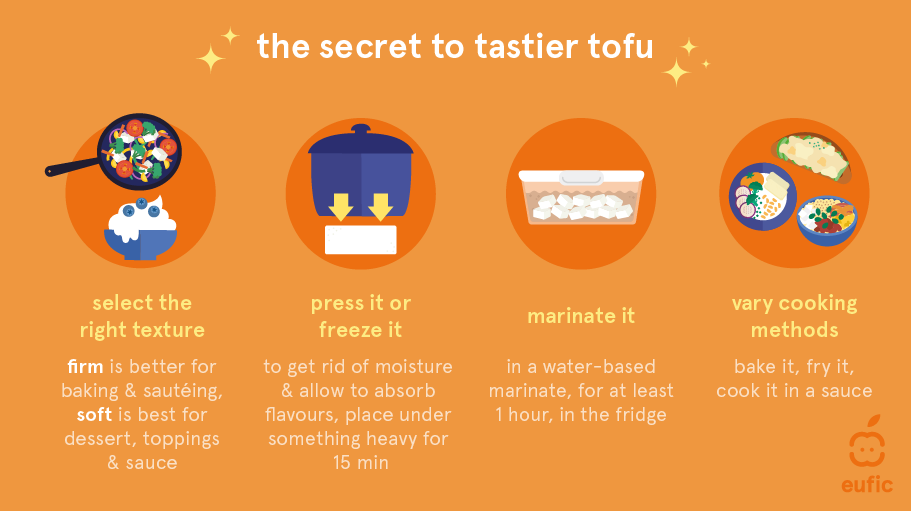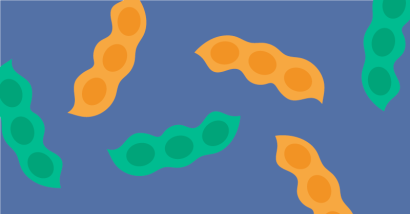Is soy good or bad for you? Here’s what the science says
Last Updated : 14 October 2024Is soy good or bad for you? This question has been a subject of much debate and speculation. In recent years, soy has gained popularity as a versatile and nutritious food source. Soy and soy-based products have found their way into a wide range of foods, from tofu and soy drinks to yoghurts and meat alternatives. But what does the science say about eating soy? This article explores what soy is, what nutrients are found in soy, and whether soy is good for us.
What is soy, and what foods contain soy?
Soy, or soybeans, are a type of legume that is native to East Asia and grown for its edible bean. Soybeans are extremely versatile. Soybeans can be eaten on their own (either as soybeans (boiled) or edamame, which are the immature soybeans within the pod which are often boiled or steamed and served with salt) or processed to make a variety of food products. such as:1
- Tofu: prepared by coagulating soy drink and then pressing the resulting curds into solid blocks of varying firmness (e.g., silken, soft, firm, or extra firm).
- Miso: a traditional Japanese seasoning paste made by fermenting soybeans with salt and koji.
- Tempeh: a traditional Indonesian food made by fermenting whole soybeans into a cake form.
- Natto: a type of fermented soybean traditionally eaten in Japan.
- Soy drink, soy vegetable alternative to yoghurt and other dairy alternatives.
Soybeans are also used to produce a range of ingredients:
- Soy flour and soy protein are used in foods such as bread, other cereal products, meat products and vegetarian meat alternatives.
- Soybean oil, which is widely used as a vegetable oil both for at-home cooking and by the food industry and is also used in the manufacture of spreadable fats such as margarines.
- Soy lecithin, which is used as an emulsifier in many foods.
- Soy sauce: a brown, salty liquid condiment made by fermenting soybeans or breaking them down with acid.
What nutrients are in soy?
Soy contains a wide range of nutrients:1
- Protein: soy is a source of high-quality protein that is well-digested. Soy also contains all nine essential amino acids in consistent amounts. Compared to other plant-based milk alternatives, soy drinks offer protein content similar to cow’s milk.
- Healthy fats: soy foods contain mainly mono- and polyunsaturated fats, with very small amounts of saturated fats.
- Fibre: soybeans provide a source of fibre. One serving of boiled soybeans (80 g), edamame (80 g), and tempeh (50 g) contains 10.6 g, 4.7 g, and 2.8 g of fibre, respectively. In contrast, tofu contains relatively little fibre due to the steps it has undergone in food processing.
- Vitamins and minerals: soy can be a good source of B vitamins, iron (although our bodies can absorb this type of iron less effectively than animal-based iron), potassium, and magnesium. For example, boiled soybeans, tempeh, and tofu are good iron sources. 100 g of tempeh contains 27% of the dietary reference value for iron. Some soy products are also high in calcium (e.g., fortified soy drinks, fortified soy vegetable alternatives to yoghurt and calcium-set tofu). A glass (200 ml) of fortified soy drink contains 25% of the dietary reference value for calcium.
- Isoflavones: soy is a uniquely rich source of isoflavones, which is a group of antioxidant-type compounds. Isoflavones are a type of phytoestrogen, meaning that they have a similar shape to our own body’s hormone oestrogen. However, unlike oestrogen, they bind differently to our oestrogen receptors and play out different actions. They can act as both activators and inhibitors of oestrogen receptors, depending on various factors, including oestrogen levels in the body (from both oestrogens produced by our body and other dietary sources of oestrogen) tissue type. This is their so-called selective oestrogenic receptor modulation action.1 As a result, their final effect may be different for a fertile woman as compared to a postmenopausal woman. Differences between individuals and how they metabolise soy isoflavones and the subsequent oestrogenic potencies have also been observed. However, more research with a larger number of people is needed for a more comprehensive understanding of their effects on humans.2

Fig. 1 – Protein content in soy products: tempeh, soybeans (boiled), edamame beans (boiled), tofu, soy vegetable alternative to yoghurt and soy drink, unsweetened, fortified.3,4
The Microbiomes4Soy project
Microbiomes4Soy is an EU-funded project that aims to elevate the nutritional quality of soybean crops, contributing to healthier plant-based protein alternatives. The project leverages microbiome-based research to develop improved seeds and identify the optimal soil microbe communities to support plant growth. This approach will enhance agricultural management, leading to the production of more nutritious soy-based products.
Is soy good for you?
Despite the abundant nutrients in soy, many concerns have been raised about its potential negative health effects, particularly in relation to the oestrogen-like effects of isoflavones. The evidence for several health outcomes are described below.
Cardiovascular disease
Early research suggested that soy protein could potentially lower high cholesterol levels. A 1995 meta-analysis indicated a 12.9% reduction in low-density lipoprotein (LDL) cholesterol when 50 g of soy protein (equal to almost 2 L of soy drink or 680 g of tofu) were eaten daily instead of animal protein.5 High LDL cholesterol in the blood is linked with an increased risk of cardiovascular disease.6 As a result, the US Food and Drug Administration (FDA) allowed manufacturers of foods to claim that “25 g of soy protein a day, as part of a diet low in saturated fat and cholesterol, may reduce the risk of heart disease.7” However, subsequent studies, including an update by the American Heart Association in 2000, reported more modest LDL cholesterol reductions. In 2017, the FDA proposed revoking the heart disease risk reduction claim given a perceived lack of consistent LDL cholesterol reductions in randomised controlled trials.8 The European Food Safety Authority also concludes that a cause-and-effect relationship has not been established between eating soy isoflavones and maintaining healthy LDL cholesterol levels.9
However, a high LDL cholesterol level is not the only risk factor for developing cardiovascular disease. High blood pressure is also one of the key risk factors.10 Eating soy is associated with a small but significant blood pressure-lowering effect in adults and thus could be part of an overall cardioprotective diet.11 Soy also has beneficial effect on other risk factors for cardiovascular disease, including improving blood vessel function, lowering inflammatory markers, reducing waist circumference, and improving atrial function and stiffness.12-17
Breast and prostate cancer
Beginning in the late 1990s, some animal research suggested that isoflavones stimulate breast tumour growth and inhibit the efficacy of several breast cancer drugs. However, research in animals does not always translate to humans (i.e., soy isoflavones may be different metabolised in animals as compared to humans). Since then, multiple studies involving women with breast cancer, women at high risk of breast cancer and healthy women showed that eating neither soy nor isoflavones affected markers of breast cancer risk.1 In fact, several large observational studies show soy intake is associated with a significantly reduced risk of breast cancer recurrence and breast cancer-specific mortality, although the specific mechanism remains unknown. One hypothesised mechanism is that soy isoflavones act as antagonists in breast tissue. They compete with more potent oestrogen produced by our body for binding to oestrogen receptors, potentially reducing the overall oestrogenic stimulation and having a protective effect on breast cancer risk. Authorities such as the American Cancer Society, the American Institute for Cancer Research, the World Cancer Research Fund, and the Canadian Cancer Society all affirm that soy can be consumed safely by women with breast cancer.18-21
There is also suggestive evidence that eating soy foods is associated with a reduction in prostate cancer risk in men. However, the evidence is too inconsistent to draw any firm conclusions.1 Although more research is needed, soy foods can still be part of a dietary approach for patients concerned about developing prostate cancer.
Reproductive hormones and fertility
Some people have speculated about whether so could be detrimental to male reproductive hormones and fertility due to concerns about isoflavones which could potentially interfere with testosterone levels.1 This led to worries about adverse effects on sperm count, reproductive health, and causing breast growth in males. However, a 2021 meta-analysis found no effects of soy or isoflavones on reproductive hormone levels in men, even with exposures far exceeding typical dietary intakes.22 The study also did not show an adverse effect of soy (isoflavones) on sperm or semen parameters. Additionally, there is no evidence that soy isoflavones result in enlarged male breasts.1
Similarly, there are no effects of soy or isoflavones on circulating reproductive hormone concentrations in women (e.g., oestrogen levels).23 Observational and clinical studies have shown a small but significant increase in menstrual cycle length in women with high soy intakes; however, it is still well within the normal cycle length range. Clinical research is limited but the available data suggests there is also no impact of eating soy on pregnancy related outcomes.1
Thyroid function
Early case reports found that infants fed soy infant formula developed goitre (swelling of the thyroid gland). This condition was later alleviated with the addition of iodine (a mineral required to produce thyroid hormones) to the formula. In the 1990s, test tube and animal studies also suggested that isoflavones in soy could potentially affect thyroid functions by interfering with the synthesis of thyroid hormones.1 However, more recent analysis, including an assessment by the European Food Safety Authority concluded that isoflavones do not affect thyroid function in postmenopausal women (the only group studied) and another meta-analysis examining the effect of soy and isoflavones on thyroid hormones also found no effect on levels of thyroid hormones.24,25
Additionally, concerns have been raised about soy exacerbating thyroid function in individuals with very low iodine intakes. However, these were countered by studies that found little evidence of iodine-related issues when people took soy supplements.26 Overall, the evidence suggests that, in moderate amounts, soy and isoflavones are unlikely to have significant adverse effects on thyroid function.1
Memory and cognitive function
A 2000 observational study raised concerns about soy intake potentially impairing cognition.27 It found that higher midlife tofu intake was associated with indicators of cognitive impairment and brain atrophy (loss of brain cells and their connections) in men compared to men who rarely ate tofu. However, the study had a limited number of men in the highest tofu-eating group, and the data on their actual intakes relied on recalling their past eating habits, which might have been biased by their memory decline. As a result, the researchers concluded that the findings were too preliminary to provide any definitive recommendations. A more recent meta-analysis of clinical trials found soy isoflavones may improve memory and overall cognitive function; however, more research is needed.28
Hot flashes
The most common menopause-related symptom that women experience is hot flashes, which are described as feelings of warmth and typically accompanied by sweating, flushing, a pounding heart, and sometimes anxiety.1 Soy is hypothesized to alleviate such symptoms due to its isoflavones with potential oestrogenic effects. The idea is that soy isoflavones may provide an oestrogen-like boost during the decline in natural oestrogen levels. Initially, studies yielded conflicting conclusions, with some suggesting limited efficacy.1 Later research emphasized the importance of genistein, a specific isoflavone found in soy. A meta-analysis showed that soy isoflavones decreased both the frequency and severity of hot flashes, particularly among those with a higher genistein intake.29 However, drawing consistent conclusions remains difficult, mainly due to the diversity in study design, length, variation in the types of soy preparations used, the quantities given, etc.
Side effects of soy
Soy is one of the 14 most common allergens in the EU.30 If soy is present in a food product, it must be clearly indicated using an allergen label (i.e., ‘soy’ is indicated in, for example, bold, italic, or underlined). If you’re experiencing adverse symptoms when consuming soy (e.g., a runny or itchy nose, dry mouth, itchy eyes, sneezing, rash, wheezing, shortage of breath, abdominal discomfort, nausea, vomiting, and diarrhoea), consult a registered dietitian/nutritionist or general practitioner for individualised and safe advice.
Summary
Soy is a nutrient-dense source of protein that can provide many health benefits. Isoflavones in soy may be similar to our hormone oestrogen, but the two are not the same. Most misconceptions stem from findings in animal studies or anecdotal evidence which have not been replicated in subsequent studies. Eating moderate amounts of soy foods has been linked to small protective health effects for cardiovascular health, breast cancer risk and recurrence, prostate cancer, hot flushes, and memory and cognitive function. The evidence does not point to any dangers from eating soy foods in people, and the health benefits outweigh any potential risks. Although no specific dietary recommendations on soy intake are in place, eating 1-3 daily servings of soy (15-25 g/day soy protein or 50-100 mg/day isoflavones) appears to be beneficial.1
Are you wanting to incorporate more soy-based foods such as tofu into your diet? Here are some secrets to make this versatile source of plant-based protein more delicious.


Microbiomes4Soy has received funding from the European Union’s Horizon Europe research and innovation programme under grant agreement No 101083671.
References
- Messina, M., Duncan, A., Messina, V., Lynch, H., Kiel, J., & Erdman Jr, J. W. (2022). The health effects of soy: A reference guide for health professionals. Frontiers in nutrition, 1837.
- Soukup, S. T., Engelbert, A. K., Watzl, B., Bub, A., & Kulling, S. E. (2023). Microbial Metabolism of the Soy Isoflavones Daidzein and Genistein in Postmenopausal Women: Human Intervention Study Reveals New Metabotypes. Nutrients, 15(10), 2352.
- Composition of foods integrated dataset (CoFID).
- EuroFIR food composition database.
- Anderson, J. W., Johnstone, B. M., & Cook-Newell, M. E. (1995). Meta-analysis of the effects of soy protein intake on serum lipids. New England Journal of Medicine, 333(5), 276-282.
- Boren, J., Chapman, M. J., Krauss, R. M., Packard, C. J., Bentzon, J. F., Binder, C. J., ... & Ginsberg, H. N. (2020). Low-density lipoproteins cause atherosclerotic cardiovascular disease: pathophysiological, genetic, and therapeutic insights: a consen
- US Food and Drug Administration. (2002). Health claims: soy protein and risk of coronary heart disease (CHD). 21 CFR 101.82. Fed. Regist, 64, 57699-57733.
- US General Services Administration. (2023). Food labelling: Health Claims; Soy Protein and Coronary Heart Disease. Retrieved from https://www.reginfo.gov/public/do/eAgendaViewRule?pubId=202304&RIN=0910-AH43 (Accessed 20/11/2023)
- EFSA Panel on Dietetic Products, Nutrition and Allergies (NDA). (2011). Scientific Opinion on the substantiation of health claims related to soy isoflavones and protection of DNA, proteins and lipids from oxidative damage (ID 1286, 4245), maintenance of
- Williams, B., Mancia, G., Spiering, W., Agabiti Rosei, E., Azizi, M., Burnier, M., ... & Desormais, I. (2018). 2018 ESC/ESH Guidelines for the management of arterial hypertension: The Task Force for the management of arterial hypertension of the Europe
- Mosallanezhad, Z., Mahmoodi, M., Ranjbar, S., Hosseini, R., Clark, C. C., Carson-Chahhoud, K., ... & Jalali, M. (2021). Soy intake is associated with lowering blood pressure in adults: A systematic review and meta-analysis of randomized double-blind pl
- Messina, M. (2016). Soy and health update: evaluation of the clinical and epidemiologic literature. Nutrients, 8(12), 754.
- Rizzo, G., & Baroni, L. (2018). Soy, soy foods and their role in vegetarian diets. Nutrients, 10(1), 43.
- Cai JS, Feng JY, Ni ZN, et al. An update on the nutritional, functional, sensory characteristics of soy products, and applications of new processing strategies. Trends Food Sci Technol. 2021;112:676-689
- Sohouli MH, Fatahi ALS, Shidfar F, et al. Impact of soy milk consumption on cardiometabolic risk factors: A systematic review and meta-analysis of randomized controlled trials. J Funct Foods. 2021;83:104499
- Asbaghi, O., Ashtary-Larky, D., Mousa, A., Rezaei Kelishadi, M., & Moosavian, S. P. (2022). The effects of soy products on cardiovascular risk factors in patients with type 2 diabetes: a systematic review and meta-analysis of clinical trials. Advances
- Man, B., Cui, C., Zhang, X., Sugiyama, D., Barinas-Mitchell, E., & Sekikawa, A. (2021). The effect of soy isoflavones on arterial stiffness: a systematic review and meta-analysis of randomized controlled trials. European journal of nutrition, 60, 603-6
- American Institute for Cancer Research. (2023). Soy: Intake Does Not Increase Risk for Breast Cancer Survivors. Retrieved from https://www.aicr.org/cancer-prevention/food-facts/soy/ (Accessed 20/11/2023)
- Rock, C. L., Doyle, C., Demark‐Wahnefried, W., Meyerhardt, J., Courneya, K. S., Schwartz, A. L., ... & Gansler, T. (2012). Nutrition and physical activity guidelines for cancer survivors. CA: a cancer journal for clinicians, 62(4), 242-274.
- Chan, D. S., Abar, L., Cariolou, M., Nanu, N., Greenwood, D. C., Bandera, E. V., ... & Norat, T. (2019). World Cancer Research Fund International: Continuous Update Project—Systematic literature review and meta-analysis of observational cohort studies
- Canadian Cancer Society. (2023). Eating well after breast cancer. Retrieved from https://cancer.ca/en/cancer-information/cancer-types/breast/supportive-care/eating-well-after-breast-cancer (Accessed 20/11/2023)
- Reed, K. E., Camargo, J., Hamilton-Reeves, J., Kurzer, M., & Messina, M. (2021). Neither soy nor isoflavone intake affects male reproductive hormones: An expanded and updated meta-analysis of clinical studies. Reproductive Toxicology, 100, 60-67.
- Hooper, L., Ryder, J. J., Kurzer, M. S., Lampe, J. W., Messina, M. J., Phipps, W. R., & Cassidy, A. (2009). Effects of soy protein and isoflavones on circulating hormone concentrations in pre-and post-menopausal women: a systematic review and meta-anal
- EFSA Panel on Food Additives and Nutrient Sources added to Food (ANS). (2015). Risk assessment for peri‐and post‐menopausal women taking food supplements containing isolated isoflavones. Efsa Journal, 13(10), 4246
- Otun, J., Sahebkar, A., Östlundh, L., Atkin, S. L., & Sathyapalan, T. (2019). Systematic review and meta-analysis on the effect of soy on thyroid function. Scientific reports, 9(1), 3964.
- Sosvorová, L., Mikšátková, P., Bičíková, M., Kaňová, N., & Lapčík, O. (2012). The presence of monoiodinated derivates of daidzein and genistein in human urine and its effect on thyroid gland function. Food and chemical toxicology, 50(8), 2774-2779.
- White, L. R., Petrovitch, H., Ross, G. W., Masaki, K., Hardman, J., Nelson, J., ... & Markesbery, W. (2000). Brain aging and midlife tofu consumption. Journal of the american college of nutrition, 19(2), 242-255.
- Cui C, Birru RL, Snitz BE, Ihara M, Kakuta C, Lopresti BJ, et al. Effects of soy isoflavones on cognitive function: a systematic review and meta-analysis of randomized controlled trials. Nutr Rev. (2020) 78:134– 44.
- Taku, K., Melby, M. K., Kronenberg, F., Kurzer, M. S., & Messina, M. (2012). Extracted or synthesized soybean isoflavones reduce menopausal hot flash frequency and severity: systematic review and meta-analysis of randomized controlled trials. Menopause
- EFSA Panel on Dietetic Products, Nutrition and Allergies (NDA). (2014). Scientific Opinion on the evaluation of allergenic foods and food ingredients for labelling purposes. EFSA journal, 12(11), 3894.

